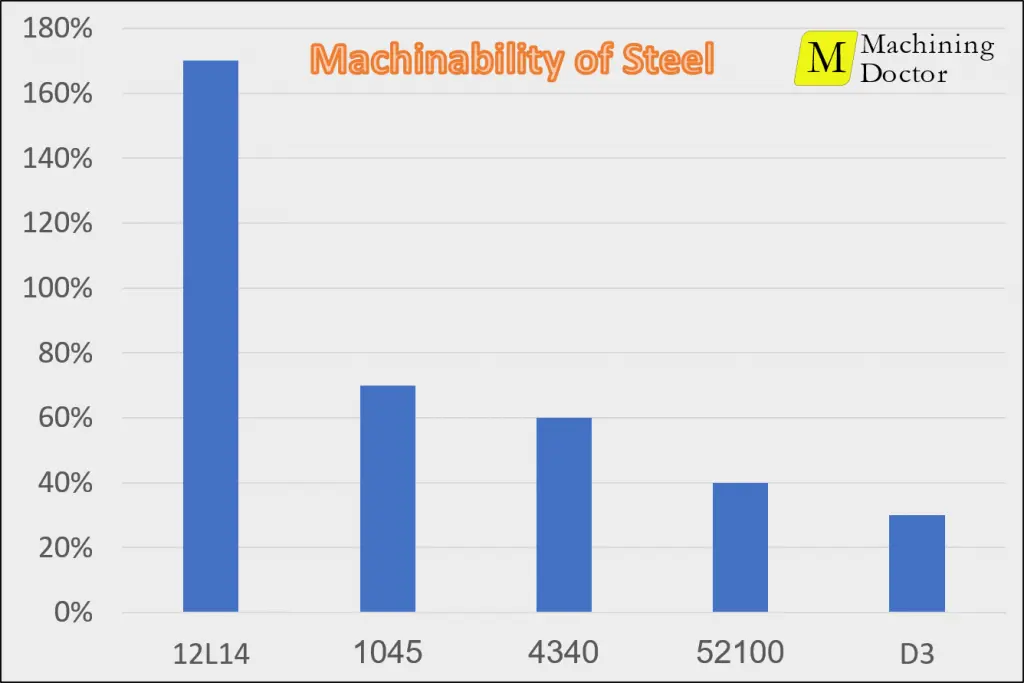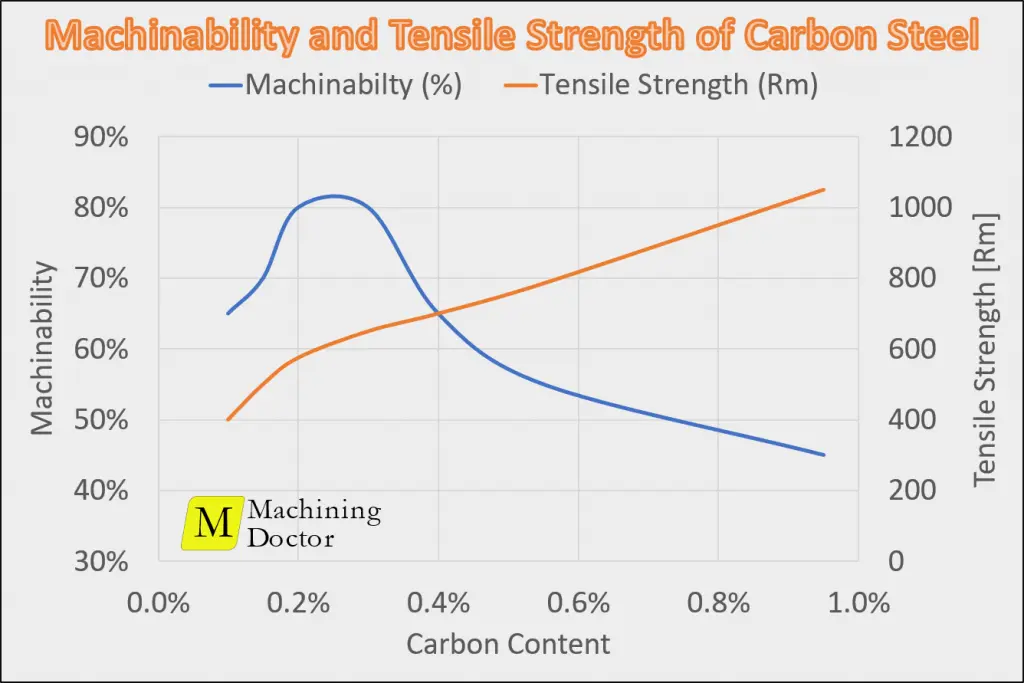Table of Contents
Steel is by far the most popular material in machine shops. Machinability of Steel ranges from free-cutting materials like 12L14, with a machinability of 170%, and up to challenging tool steels such as D3 or O1 with Machinability of 30-40%. We will break down this big family of materials into sub-groups and discuss the machinability of each one.


What is steel?
Steel is Iron (Fe), with the addition of 0.1 – 2.5 wt. % of Carbon (c). Besides carbon, steel may also contain many other alloying elements up to a total content of around 20%. Pure Iron is very ductile. By “playing” with the mix and amount of the different alloying elements, Iron gains a range of unique mechanical properties. However, some of these additives also harm the machinability rating.
Carbon Steel
(SAE 10xx Series)
Carbon steel is the simplest and cheapest form of steel. It is usually defined as steel made of Iron (Fe) with small Carbon (C) addition but without any other alloying elements. This statement is not accurate since most Carbon Steels also contain small amounts of Manganese (Mn), Phosphorus (P), and Sulfur (S). The SAE designation of Carbon steel is in the format of 10xx, where xx indicates the amount of carbon. For example, 1020 contains 0.2% of carbon, and 1045 contains 0.45% of carbon.
Carbon (C) is the primary alloying element in steel. It increases hardness and tensile strength, as well as responds to heat treatment (hardenability). Carbon steels usually have up to 1% carbon content. The machinability is very sensitive to the amount of carbon since carbon directly influences the hardness of steel. The “Sweet Spot” that yields the highest machinability rating is around 0.2%. Steel with less than 0.15% Carbon is very soft; thus, it is almost impossible to break the chips, and BUE is easily formed on the cutting edge. Above 0.3%, the material becomes gradually harder, and therefore wear is formed faster on the cutting edge. You can learn more about Carbon Steel here.

Summary – Machinability Rate 40-80%
In carbon steel, the carbon content is King. The carbon content of 0.2-0.3% brings the best machinability rate. 0.15% and below creates ductile steel with unbreakable chips. As the carbon content grows between 0.4-1%, the machinability rate gradually decreases.
Carbon Steel – Machinability Chart
Free-Cutting Steels
(SAE 11xx, 12xx, 12Lxx)
Free-Cutting (Free-Machining) Steel is a nickname for carbon steel with an increased amount of alloying elements for the sole purpose of improving its machinability.
11xx series: the amount of Sulfur (S) is increased from 0.05% in plain carbon steels to 0.1%. It adds about 20% to the machinability when compared with the equivalent materials in the 10xx series. On the other hand, the tensile strength decreases by about 10%, and the material is more brittle.
12xx series: Sulfur (S) content is further increased to 0.25%, and Phosphorus (P) content is increased from 0.04% in the 10xx series to 0.5%. As a result, the machinability increases by another 40% at the price of further decline in mechanical properties.
SAE 12L14 is a free-cutting steel where the Phosphorus is replaced by 0.25% of Lead (Pb), which boosts the machinability by another 35%. This improvement happens because the Lead melts locally at the point of cut, thus reducing friction and providing natural lubrication. However, many material manufacturers and machine shops try to avoid lead supplements due to environmental damage and health risks. You can learn more about Free-Machining Steel here.
Machinability rate comparison between plain carbon steel and freecut steels with the same carbon content
In the above table, you can see the net effect of the freecut additives on machinability.
Summary – Machinability Rate 70-170%
From the machinist’s perspective, free-machining steels are the best. However, design engineers try to avoid them due to their inferior mechanical properties.
Low Alloy Steels
(SAE 4xxx, 5xxx, …. 9xxx)
There is no scientific definition, but in practice, low allow steels are carbon steels with additional alloying elements (on top of the carbon and Manganese) of up to 5%. These elements are added to improve the strength, toughness, corrosion resistance, wear resistance, hardenability, and the steel’s hot hardness. The list of alloying elements is long, but for our discussion, it is enough to focus on the three main ones:
Molybdenum (Mo) is Present in all the low alloy steels (except the 5xxx and 9xxx series), in weight content of 0.15-0.35%. It Increases the toughness and has no adverse effect on machinability.
Chromium (Cr) is Present in most low alloy steels with a weight content of 0. 5-1.5%. Chromium is mostly known to improve corrosion resistance and therefore is a significant element in stainless steel. However, this is achieved only at higher amounts, above 5%. Most stainless steels have 12-20% Chromium content, and at these levels, it also decreases machinability. However, at lower content, as in low alloy steels, it improves hardenability without a negative effect on machinability. You can learn more about Alloy Steel here.
Nickel (Ni) is added to 43xx, 48xx, 8xxx series at amounts of 0.5-3.5%. Nickel improves the toughness of the steel, but at the expense of decreasing the machinability.
Summary – Machinability Rate 40-75%
Low alloy steels have nearly the same machinability rating as carbon steels with equivalent carbon content, except for materials containing additional nickel content. (The most common example is the widely used SAE 4340 DIN 35CrNiMo6). However, carbon content is still the dominant factor influencing machinability. Materials like SAE 52100 DIN 100Cr6 that have 1% carbon content, show the lowest machinability rating in this group, although they don’t contain any Nickel.
Low Alloy Steel – Machinability Chart
Tool Steels
High alloy Steels (Ax, Ox, Hx, Dx, Mx, etc.)
High alloy steels can contain 5-20% content of alloying elements. They are called tool steels since they are mostly used to manufacture tools for cutting, pressing, extruding, and coining metals and other materials. You can learn more about Tool Steel here.
Tool Steels Classification (Main Groups)
| SAE | Description | Properties | Machinability |
|---|---|---|---|
| A2-A10 | Air-hardening, cold-work steels | Carbon content of 0.7-1.25% leads to lower machinability | 30-40% |
| O1-O7 | Oil-hardening , cold-work steels | Carbon content of 1-1.5% leads to lower machinability | 30-40% |
| D2-D7 | High-carbon, high-chromium, cold-work steels | Very high Carbon content of 1.5-2.5% leads to poor machinability | 20-30% |
| H10-H19 | Chromium hot-work steels | Medium Carbon content around 0.4% with Chromium around 5% | 50-60% |
| M1-M62 | Molybdenum based high-speed steels | Molybdenum 5-10% / Tungsten 2-10% | 20-40% |
Summary – Machinability Rate 20-50%
The steels in this group either have high carbon content above 1% and/or additional alloying elements in high quantities leading to a very poor machinability rating.
Tool Steel – Machinability Chart








